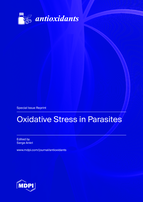Oxidative Stress in Parasites
A special issue of Antioxidants (ISSN 2076-3921). This special issue belongs to the section "Health Outcomes of Antioxidants and Oxidative Stress".
Deadline for manuscript submissions: closed (20 April 2023) | Viewed by 34605
Special Issue Editor
Special Issue Information
Dear Colleagues,
Reactive oxygen species (ROS) play a key role in eliciting oxidative stress (OS) response in cells. They are capable of damaging essential biomolecules in cells, such as DNA, proteins, and lipids, and they primarily inhibit cellular functions. During the invasion process, parasites encounter OS in their host. A main source of OS is the generation of ROS by cells of the immune system. Many anti-parasitic drugs are also able to induce oxidative damage directly or indirectly by targeting the antioxidant defence system of the parasite. Parasite redox biology is vital for understanding parasite–host interactions, adaptations, and resistance to redox-active antiparasitic molecules.
We invite you to submit your latest research findings or a review article to this Special Issue, which should be focused on the redox biology of parasites. This research work can be oriented towards the redox changes occuring during differentiation and drastic transitions between environments that take place during parasitic complex life cycles, oxidative stress encountered by parasites in response to the activation of the immune system, the redox biology of intracellular parasites, the development of ROS-generating antiparasitic compounds, the study of redox signalling molecules in parasites, or any other aspect of the redox biology of parasites.
Prof. Dr. Serge Ankri
Guest Editor
Manuscript Submission Information
Manuscripts should be submitted online at www.mdpi.com by registering and logging in to this website. Once you are registered, click here to go to the submission form. Manuscripts can be submitted until the deadline. All submissions that pass pre-check are peer-reviewed. Accepted papers will be published continuously in the journal (as soon as accepted) and will be listed together on the special issue website. Research articles, review articles as well as short communications are invited. For planned papers, a title and short abstract (about 100 words) can be sent to the Editorial Office for announcement on this website.
Submitted manuscripts should not have been published previously, nor be under consideration for publication elsewhere (except conference proceedings papers). All manuscripts are thoroughly refereed through a single-blind peer-review process. A guide for authors and other relevant information for submission of manuscripts is available on the Instructions for Authors page. Antioxidants is an international peer-reviewed open access monthly journal published by MDPI.
Please visit the Instructions for Authors page before submitting a manuscript. The Article Processing Charge (APC) for publication in this open access journal is 2900 CHF (Swiss Francs). Submitted papers should be well formatted and use good English. Authors may use MDPI's English editing service prior to publication or during author revisions.
Keywords
- Redox biology
- Oxidative stress
- Parasites
- Antioxidant enzymes
- Infection process







